
- Razor sharp 13-inch
- Bi-directional cut
- 3X tooth design

- Precision-ground steel pruner
- 12″ double-grind saw
- Secure double locking system

- Versatile 3 pole system
- Aluminum ferrules
- Low profile head

- 3-extension
- 4-poles/sections
- Sk4 high carbon steel metal

- Double-pulley pruner
- FG Series poles
- 16-inch saw blade

- Easily cut high branches
- Power-Lever technology
- Precision-ground steel pruner

- 2 in 1 design
- High carbon steel blades
- Telescoping pole design

- Color: Yellow
- Duty double thick blade
- Item Weight: 10 pounds

- 4cm thickness
- With a scissor on the head
- More durable

- Size: 4m
- Lightweight construction
- Shoulder strap
Choose the Best Manual Pole Saw
Customer’s Choice: the Best Rated Manual Pole Saws
661 users answered this survey. Please help us improve this review!
A manual pole saw (pole pruner or tree pruner) is a quite versatile and multi-purpose tool. It is used for cutting and trimming the twigs and branches of small-to-medium size.
The main reason to use a manual pole saw is to have control over the trimming process. This instrument is irreplaceable when your task is to trim a few tall trees or bushes. It is not a powerful cutting tool. So if you have a huge garden with many trees that need pruning, a manual pole saw is not the best choice. But for keeping the small garden nice-looking, this tool fully meets the requirements.
How is a manual pole saw different from corded pole saws?
A manual pole pruner has only two limitations. First and foremost, you should use physical force to trim the branches with a pole saw. You might get tired if you want to cut many tall trees with this instrument.
The second limitation is the low speed of work. Cutting and trimming is a time-consuming process. Compared to other corded and electric pruners, a manual pole saw will make the process of pruning much longer.
But if you are not afraid of these limitations, a manual pole saw can offer a lot of benefits:
- Lightweight tool. A manual pole saw weighs far less than any corded pole saw or chainsaw. Because it is not equipped with a heavy motor and battery. The pole is usually made of very durable but light material. And the saw blade is also lightweight. It is a perfect instrument for people who have arthritis or rheumatism;
- Cheaper than any other powered saw. A manual pole pruner has a very simple design without a fuel tank or batteries. That is why it will cost you only a few bucks. While the powered saw’s price can reach $100 or higher;
- Easy maintenance. It is very easy to keep the pole and blades clean from any debris. It doesn’t have any moving parts that need lubrication. You just should keep the saw blade sharp enough;
- Very portable. Manual pole saws are portable because it doesn’t include any bulky attachment. The power outlet won’t limit you. You can easily take it whenever you require;
Since a manual pole saw doesn’t use any fuel or electric power it is eco-friendly. That is why the instrument produces low noise. Besides, you may use this tool in any weather, even when it is raining. Also, it is much safer than other pole pruners when you trim the trees above your head.
The following article will highlight the features of a few popular manual pole saw models. You will also learn how to choose a manual pole saw to meet your requirements.
Table of Contents
DocaPole 6-24-inch Saw – the best tree trimmer!
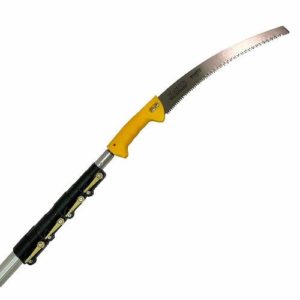 The DocaPole telescopic pole saw can become an irreplaceable gardening tool if you need to prune lightweight vines, branches and foliage from time to time. It can be equipped with other attachments – a standard threaded tip is good for this.
The DocaPole telescopic pole saw can become an irreplaceable gardening tool if you need to prune lightweight vines, branches and foliage from time to time. It can be equipped with other attachments – a standard threaded tip is good for this.
For instance, you may add the Acme-threaded extension. Gardeners claim about using this pole saw in the rain because of the rust-free and hard-chrome finish.
This lightweight pruning instrument won’t do heavy jobs. Use it only for trimming light branches and twigs, to cut the leaves or vines. For heavier pruning, use the DocaPole 6-24 Foot Double-Duty saw with a thicker aluminum pole.
Fiskars 12 Foot Saw – the best for cutting large branches!
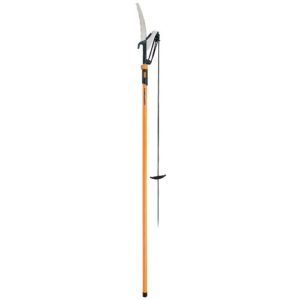 The Fiskars pole saw is a great gardening tool capable of trimming and cutting the branches. This lightweight tool can be good for the heavy-duty use when it comes to pruning the tall trees and bushes. In fact, it is more a grind saw than a pole saw.
The Fiskars pole saw is a great gardening tool capable of trimming and cutting the branches. This lightweight tool can be good for the heavy-duty use when it comes to pruning the tall trees and bushes. In fact, it is more a grind saw than a pole saw.
It comes with a smart double flip-locking system so you could feel safe when pruning the trees overhead.
This tool is very simple to use. Also, the Fiskars pole saw extends only to the required size thanks to the flip-lock system.
Jameson LS-6PKG-6 Pole Saw Kit – the best for versatility!
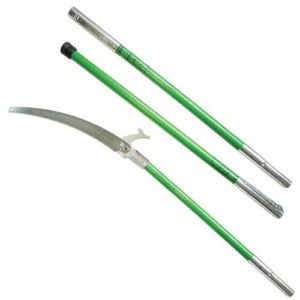 For the price of a single-pole saw, Jameson offers the kit with 3 pole saws. You will be able to cut through thin or thick branches, dense foliage or twigs at different heights. Each instrument’s length is 6 feet long. Every tool from the pole saw kit features a Tri-cut blade.
For the price of a single-pole saw, Jameson offers the kit with 3 pole saws. You will be able to cut through thin or thick branches, dense foliage or twigs at different heights. Each instrument’s length is 6 feet long. Every tool from the pole saw kit features a Tri-cut blade.
These pole saws have no loppers. This kit also doesn’t come with any storage bag. You will have to invest in these accessories and attachments. Elderly people may want to skip these pole saws because they are good for strong hands.
Fiskars 14′ Extend Tree Pruner – the best for comfort!
 Another Fiskars pole saws with great technical parameters. This particular pole saw extends up to 14 feet. Thanks to the Power-Level technology, the instrument turns into a precision-ground steel pruner for trimming and cutting through 1.8-inch branches.
Another Fiskars pole saws with great technical parameters. This particular pole saw extends up to 14 feet. Thanks to the Power-Level technology, the instrument turns into a precision-ground steel pruner for trimming and cutting through 1.8-inch branches.
The pole saw comes with a standard 15-inch WoodZig saw that can remove large and thick branches of the tall trees.
You may pick this instrument to get full control when pruning the trees. It is extremely comfortable due to advanced handles and powerful technology. The instrument can cut through any wood, even palm trees.
Jameson FG-Series Manual Saw – the best for durability!
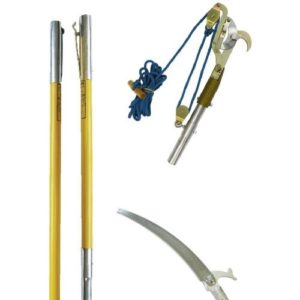 The Jameson kit of a tree pruner with two 6-foot fiberglass poles is capable of cutting through thick branches. Its 16-inch Barracuda Tri-cut saw blades deliver smooth cuts. The bright-colored tool can become a good addition to any collection of gardening instruments.
The Jameson kit of a tree pruner with two 6-foot fiberglass poles is capable of cutting through thick branches. Its 16-inch Barracuda Tri-cut saw blades deliver smooth cuts. The bright-colored tool can become a good addition to any collection of gardening instruments.
This professional instrument has a base pole for a 6-foot reach or extended 6-foot pole for the 12-foot reach. It has a non-fiberglass surface layer to prevent any risk of fiber blooming. The Jameson manual pole saw is customizable and easy to use.
The Buyer’s Guide
Major functions
Unlike electric or gas pole saws, a manual pole pruner is good only for small backyard work and home use. Typically, manual pole saws have a long extension rod that allows controlling the blade direction. But these pole saws are lightweight,
Saw and blades
A pole saw should cut and be sharp. The saw blades must be made from lightweight but durable material. They should easily cut through the thin and thick branches (check the cutting capacity before buying – some pole saws can cut only through 1-inch twigs and that is it). For instance, high-quality manual pole saws have the carbon steel blades with the anti-rust coating. Sometimes the blades have a resin layer to provide lower friction when trimming. You may want to buy a pole saw with detachable blades in case of replacing old or broken saw. Or for more convenient storage.
Pole
Manual pole saws offer a wide range of pole length for maximum reach. For instance, if you have mature and taller trees to cut, you should pick a manual pole saw with a long extension rod. Just look at the trees and bushes in your garden and think about the pole length that you actually need.
The pole’s shape and materials are also important. A good pole must be lightweight and sturdy material. It shouldn’t shake or slide when you trim the branches overhead. Consider choosing the instrument with an extension rod made of fiberglass, steel and aluminum. Avoid any tools with wooden poles.
The maximum reach of an extension rod varies from 15 to 26 ft. If this is not enough for you, consider buying an extension attachment for additional reach.
Cutting capacity
Depending on the length and type of the saw blade, each pole saw has a unique cutting capacity. For instance, a long saw blade will cut through thicket twigs and branches. Most blades can cut through the branches with a diameter of 6 inches to 13 inches. Carefully check the technical specifications – typically manufacturers specify the cutting capacity of a particular pole saw.
Weight
It would be more reasonable to buy a lightweight pole saw so you could work longer without your hands getting tired. The weight of a manual pole saw depends on the build quality, material and the pole’s length. Usually, manual pole saws weigh from 3 to 7 lbs. The instrument shouldn’t feel heavy when you are trimming the branches overhead. Also, the weight distribution requires the balance even if the pole is extended to the maximum.
Durability
The great build quality and durability of the manual pole saw is the most important factor. Of course, high-quality instruments may cost a bit more. But if you need to use this tool more than once or twice per year, then a bit pricier but more durable pole saw will be a good investment.
This is the most crucial specification when you choose a pole saw. The rod should not break or bench under the heavy load when you are cutting the twigs. That is why the rod must be made from steel or aluminum. The reputable pole saw brands invest in the build quality of their instruments. Because it is more important to buy the durable instrument once and for many years than pay for new cheap tools every year.
Price
Like any gardening tools, manual pole pruners vary in price. You should select an instrument that works for your budget. Just be realistic about the features you look for in a manual pole saw. It may be unreasonable to pay $80 for a manual pole saw that you will use once or twice per year. But paying about $100 for the instrument that you use 20 times a year is a totally different deal.
Factors to Consider When Buying Manual Pole Saws
When it comes to buying a manual pole saw, there are several factors to consider to ensure that you get the best tool for your needs. This table provides a comparison of various indicators that can help you make an informed decision.
| Indicator | Description |
|---|---|
| Blade Length | The length of the saw blade, which determines how thick branches it can cut. |
| Material | The type of material used for the blade, such as steel or carbon steel, which affects its durability and cutting performance. |
| Telescoping Pole | Whether the pole is telescoping or not, which determines the length and reach of the saw. |
| Grip | The type of grip on the handle, which affects comfort and control during use. |
| Weight | The overall weight of the tool, which affects ease of use and maneuverability. |
| Price | The cost of the manual pole saw, which is an important factor to consider when making a purchase. |
This table provides an overview of the key indicators to consider when buying a manual pole saw. By comparing these factors across different models and products, you can make an informed decision and choose the tool that best meets your needs and budget. Keep in mind that the optimal manual pole saw for you will depend on your specific requirements, such as the types of trees and branches you need to cut, your level of experience, and your budget.
FAQ Manual Pole Saws
How thick branches can be cut with manual pole saws?
This form of pole saw would perform well in terms of cutting capacity on tree branches between 3-8 inches in diameter. A little maintenance is required. Unable to be picked under hot environments. More lightweight, louder and compact than other control choices.
How should you use a manual pole saw for trimming trees?
It is not that difficult to trim trees and thick twigs with this manual tool. Just stay alert and cautious when following these steps:
- Clean the zone below the branch of any dangers for the ride, including broken branches or unstable material, and take care of any obstacles on your way – think of nasty exposed roots. This preliminary action will help you identify the region, so you can navigate through it easily.
- Measure the gap from your height to the tree’s branch you would like to remove, if necessary. Ensure that the telescopic tree pruner will access the branch without a ladder being needed.
- Bring the tool to an upright direction with both hands and wait before it gets the required balance. Place the saw on the branch you intend to trim until you have acquired control of its weight.
- Without losing the lever, switch to a location where you can place the end at shoulder height. At this point, instead of being vertical, the pole saw must be placed at an angle between the branch and the pole saw you hold.
- Begin steadily with the first movements – hold the pole in the perpendicular position to the blade’s tip. This move will help you create a groove through the branch, so you can cut quicker and safer.
- While within the groove the saw is mounted, raise the cutting pace. Making sure you always hold an eye on the branch, so you can escape safely until it falls to the ground. Clean the field, and begin to cut some other branches in the same steps.
Manual vs. electric pole saws: what is the best tool?
Although manual tree saws need you to use your power to break the tree branches, automatic tree pruners are almost like mechanical chainsaws, cutting easily right through the thicker trees.
If you want a manual or an electric tree pruner is always a question of volume of operation. If you have a tiny garden with just a few plants, a manual pruner should be enough. However, if the trees are aged and have dense roots, you can be assisted by an electric tree pruner to cut them quicker. If you have a wide garden with tons of plants, an electric tree pruner is also a great option.
Features of electric saws:
- There are a few types – corded and cordless instruments. Gas pole saws can be also referred to this category – only their engines do not rely on combustible fuel;
- Different reaches and sizes. Consider picking the electric devices that may extend around 6-10 ft;
- Corded models are more powerful but less mobile. Cordless electric pole saws are more mobile and lightweight but they can’t trim thick and long tree limbs;
- Additionally, cordless pole saws that apply a rechargeable battery package are more eco-friendly;
Features of manual saws:
- Reliable tools with a simple design;
- Longer blades and extendable handles;
- Lighter than electric devices;
- More budget-friendly than other pruners;
- More control during the process;
- Can make quicker cuts on smaller twigs and branches;
Why pick a manual pole pruner?
Manual pole saws are also the right option for trimming branches, small or large. These tools are lightweight, quick to carry, and won’t leave you (if you’re careful) with a sore back. They can be used in lengths much longer than driven saws.
What’s the perfect manual pole saw length?
Although most manual saws for pruning on the U.S. market can differ in duration, the available standard sizes range from around 10-16 feet. While there is no perfect duration, we recommend attempting anything in the 12-foot to 14-foot range, this will give you both a shorter pole power but also a longer one’s scope.
What is the perfect blade length for a manual pole saw?
The typical style of manual pole saws comes with a clipper for snipping off smaller twigs, and a saw blade for trimming massive branches. They are typically higher, so you can hit branches that are many feet up the tree with a manual pole saw.
The delicate construction of the blades and clippers minimizes the chance of fungus and mold spores to get into the wood. The downside to manual pole saws is that you are going to be the one giving control to the saw and it may be difficult at first.
The ideal blade length for a manual pole saw is 15 inches.
Another aspect to watch out for when choosing a suitable pole saw to hack the trees and hedges is the duration of the cutting blade. Cutting bar duration is typically represented in centimeters, literally refers to the length of the blade – i.e. the cutting bar. The number defines the suitability of your pole saw for cutting dense branches. If you go for a manual pole saw, a longer blade lets you cut bigger branches with less effort, while at the same time offering you more strength quality for every blade transfer.
The TPI (Teeth Per Inch) represents the number of teeth that the blade has. A 15-inch blade with 11 + TPI is considered to be a fine blade whereas anything less is considered to be coarse, particularly about 5-6 TPI. A fine-tooth blade is better for hardwood sawing while a coarse blade is great for softwood and green plants.
Note you can slash faster with a longer blade per move. That much is very simple to understand. You’ll need to execute further strokes for a shorter saw blade to remove the same volume of wood as for a longer blade.
What are the benefits of using a manual pole saw?
Manual pole saws are lightweight, easy to use, and don’t require any electricity or fuel. They are also relatively quiet compared to gas or electric models, making them a good choice for use in residential areas. Additionally, manual pole saws are typically less expensive than powered models.
What should I look for when shopping for a manual pole saw?
When shopping for a manual pole saw, you should consider the length and weight of the pole, the quality of the saw blade, and the overall build quality. A comfortable grip is also important, especially if you plan to use the saw for extended periods of time.
What are some tips for using a manual pole saw safely?
To use a manual pole saw safely, you should always wear appropriate protective gear, such as eye and ear protection, gloves, and sturdy footwear. You should also be aware of your surroundings and avoid using the saw in wet or slippery conditions. Finally, you should make sure to follow the manufacturer’s instructions for proper use and maintenance.
What are some common maintenance tasks for manual pole saws?
To keep your manual pole saw in good condition, you should regularly clean and lubricate the saw blade, and inspect the blade for signs of wear or damage. You should also store the saw properly when not in use, and avoid leaving it exposed to moisture or extreme temperatures.
Can a manual pole saw be used for trimming thick branches?
Manual pole saws are generally designed for trimming branches up to a certain thickness, usually around 1-2 inches in diameter. However, the thickness that can be cut will depend on the blade quality and user strength.
What are some common types of saw blades for manual pole saws?
The most common types of saw blades for manual pole saws are bypass and pruning blades. Bypass blades are typically used for clean cuts on green wood, while pruning blades are designed to cut through thicker, harder wood.
How can I extend the reach of a manual pole saw?
To extend the reach of a manual pole saw, you can purchase additional extension poles that attach to the existing pole. However, adding too many extension poles can make the saw difficult to control and reduce cutting efficiency.
What are some alternatives to using a manual pole saw?
Alternatives to using a manual pole saw include gas and electric-powered pole saws, pruning shears, and handsaws. The best tool for the job will depend on the thickness of the branches, the height of the tree, and the user’s comfort and skill level.
How do I know when it’s time to replace the saw blade on my manual pole saw?
You should replace the saw blade on your manual pole saw when it becomes dull, damaged, or difficult to cut with. Signs of damage may include missing or bent teeth, cracks, or excessive rust. You should also replace the blade if it has become too short due to frequent sharpening.
Video Tutorial: Installing Corona Tree Pruner Blade
Major criteria for purchasing a manual sawing instrument:
- Length – it’s preferable to pick a cutter with the extendable handle (no less than 4 ft.);
- Material – we tried to limit our initial row of sawing instruments to the ones made of aluminum, steel or fiberglass. Also, pay attention to the instrument’s weight – don’t pick a too light or sturdy saw;
- Blade – the most important part of a manual tool with an extending pole. It must be made of lasting, top-notch material fully resistant to rust. If you manage to keep such a blade clean (especially teeth), it will serve you for many years;
Final thoughts
As you might have noticed, the best manual pole saw is not necessarily the priciest. You may easily get a high-quality tool at an affordable cost. Check the expert recommendations about a few popular models listed in this review. You may want to buy a manual pole saw with the best performance rates, according to your requirements. In such a way, this instrument will be a good investment.

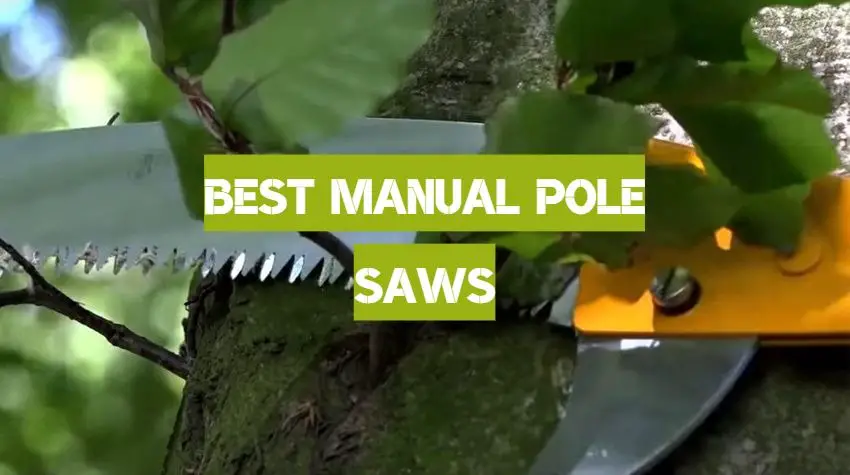





A manual pole saw is a staple landscaping tool. You have to own one! I have one with advanced tooth design that handles strictly bi-directional cuts. It does what I need and that is what counts! I have an electric one for anything more serious, but you could get away with a double-pulley pruner or other style if needed.
Such a great idea! I’ve never seen anything like one of these pole saws. Definitely going to get myself one and test the waters. It seems to me, using one of these would make it incredibly easy to landscape and would lessen the hassle of yard work.
What I like about Jameson is that they offer so much for such a low price. Just imagine how much money you would have to pay for 3 pole saws. Well, Jameson LS-6PKG-6 pole saw kit is basically composed of 3 pole saws and costs as little as one. You can cut through thick branches or thin ones. The tools have a tri-cut blade which does a swell job and they are around 6 feet long. Well worth it in my opinion.
Hello, Leo! Thanks for sharing your experience.